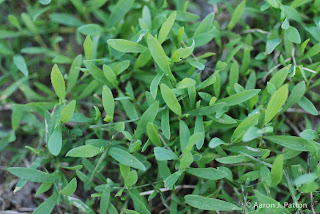Weed of the Month for March 2013 is Large Crabgrass
Large Crabgrass
Biology: Large crabgrass ( Digitaria sanguinalis ), smooth crabgrass (Digitaria ischaemum), and to a lesser extent southern crabgrass (Digitaria ciliaris) are all species found in the Midwest that are collectively referred to as crabgrass. Large crabgrass is probably the most common of these in Indiana lawns. Combined, these crabgrass species are often considered to be the most problematic weed in lawns. Large crabgrass is summer annual grass that typically germinates in April in the Midwest (late March in southern areas and late April in northern areas). A germination tracker at www.gddtracker.net can be used to track the germination of crabgrass.
Identification: Large crabgrass is one of the first summer annual grasses to germinate in Indiana. Look for it first in bare soil areas like a garden or very thin turf areas and in areas with south facing slopes. First germination has occurred between March 22 and April 20 in the Lafayette area the past several years. Initial seedlings have an almost oval shaped, cotyledon.
After the first leaf emerges, plants may remain small for several weeks if the temperatures are cool. Additionally leaves will develop and eventual plants will begin tillering in June. If you look close at large crabgrass (also sometimes called hairy crabgrass) you will see hairs on the leaves (blade and sheath) and a membranous ligule. If the leaf sheath and upper leaf blade are mostly smooth (hairless) then you likely have smooth crabgrass.
As the plants mature they tiller and form small clumps. Large crabgrass also can produce stolons and root although it doesn’t spread far and remains mostly bunch type in growth habit.
Cultural control: Proper mowing (higher mowing heights), proper fertilization (some rather than none to improve turf density), irrigation to prevent summer dormancy during drought, and aerification of compacted areas to improve turf health are all cultural practices that can be used to reduce crabgrass.
Biological control: Some organic herbicides are available. The predominant organic herbicide in turfgrass systems is corn gluten meal for preemergence crabgrass control. This product has shown to be effective in northern states in lawns, although tests in Indiana and states south of Indiana show it has limited efficacy on crabgrass and that encouraging a dense turf through proper mowing, irrigation, and fertilization is equally effective.
Chemical control: Crabgrass can be controlled using preemergence or postemergence products.
Dithiopyr (Dimension), pendimethalin (Pendulum), and prodiamine (Barricade) are common ingredients in preemergence crabgrass products. These herbicides inhibit cell division and prevent crabgrass seeds from properly emerging. Since these herbicides work on germinating seeds, you must apply them prior to germination — with the exception of dithiopyr, which controls crabgrass after germination until it reaches one tiller.
Another approach to controlling crabgrass is to use postemergence herbicides after crabgrass has already emerged. Dithiopyr, quinclorac (Drive and others), MSMA (sod and golf), mesotrione (Tenacity), Fenoxaprop (Acclaim Extra) and other herbicides containing these ingredients can be used for postemergence crabgrass control. Each of these ingredients offers a slightly different spectrum of activity and works on specific sizes of crabgrass. Pick one based on the size of crabgrass you're treating and the other weeds you have present in the area.
For more information on weed control, search this blog (search box in upper left corner of page) and archived turf tip postings and check out our Turfgrass Weed Control for Professionals Publication.
Aaron Patton, Turfgrass Extension Specialist




















